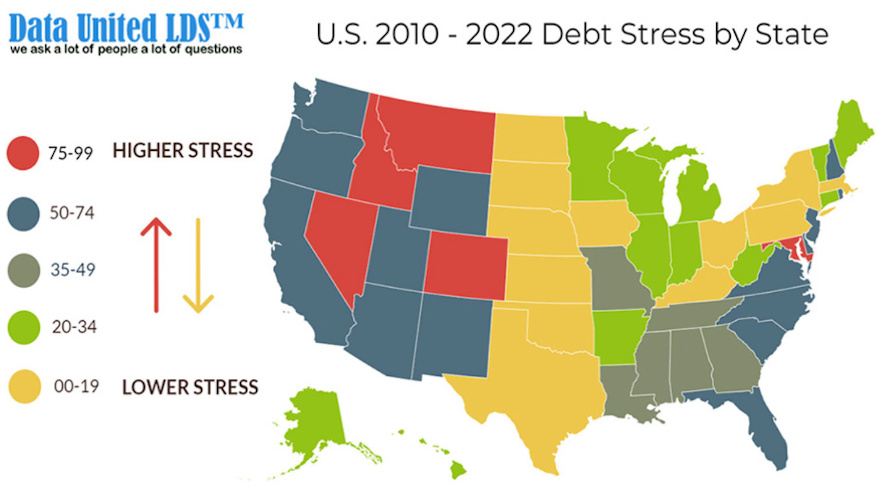While employment continues to stabilize, consumer confidence and debt-free aspirations sag

Chart courtesy of Data United LDS.
A variety of insights and trends from Data United LDS, the Conference Board, Fitch Ratings and Cox Automotive combined to offer quite a potential picture of the consumer who already has a contract in your portfolio or who might be getting set to take delivery at your dealership.
Let’s start with the upbeat data from Cox Automotive that focused on one of the most important pieces in being able to secure credit for a vehicle and maintain monthly payments: an improving employment scene.
Chief economist Jonathan Smoke noted this week that as of April 9, 1.42 million people were on traditional unemployment benefits, which was 346,000 lower than the claims level before the pandemic began. The Cox Automotive expert pointed out that the broadest measure of continuing claims was 1.62 million, according to the latest data from the week ending April 2.
“The total number of people receiving some form of benefit is 481,000 lower than the 2.1 million level before the pandemic began,” he continued in his Smoke on Cars blog. “Initial claims declined by 2,000 last week to 184,000 from an upwardly revised 186,000 the prior week. Weekly initial claims were 13,000 lower than they were leading up to the pandemic in 2020 and are at levels that have not been lower in more than 52 years.”
While that particular employment trend hasn’t been seen since the start of the 1970s, information from the Conference Board showed that some consumers still are facing a thicket of financial concerns.
The Conference Board Consumer Confidence Index decreased slightly in April, after an increase in March. The Index now stands at 107.3, which is down from 107.6 in March.
The Present Situation Index — based on consumers’ assessment of current business and labor market conditions — fell to 152.6 from 153.8 in March.
However, the Expectations Index — based on consumers’ short-term outlook for income, business, and labor market conditions — ticked up to 77.2 from 76.7.
“Consumer confidence fell slightly in April, after a modest increase in March,” said Lynn Franco, senior director of economic indicators at the Conference Board. “The Present Situation Index declined, but remains quite high, suggesting the economy continued to expand in early Q2. Expectations, while still weak, did not deteriorate further amid high prices, especially at the gas pump, and the war in Ukraine. Vacation intentions cooled but intentions to buy big-ticket items like automobiles and many appliances rose somewhat.
“Still, purchasing intentions are down overall from recent levels as interest rates have begun rising,” Franco continued in a news release. “Meanwhile, concerns about inflation retreated from an all-time high in March but remained elevated. Looking ahead, inflation and the war in Ukraine will continue to pose downside risks to confidence and may further curb consumer spending this year.”
And speaking of spending, a 12-year project by Data United LDS uncovered several key findings through a consumer debt survey orchestrated between 2010 and 2022
Data United LDS discovered 21% of Americans have given up hope of ever becoming debt free in their lifetime.
Data United LDS also indicated 27% of respondents said they don’t know if they will ever be debt free, while 62% of respondents said they had no financial education from parents and/or school.
The firm went on to mention that highest debt stress was reported in Colorado, Nevada, Idaho, Montana and Maryland.
“I wanted to take a deep dive in to understanding how personal debt affects people psychologically. I want to know more than just what their numbers are (credit score, monthly income, age, total debt). I want to shed light on their plight because I went through personal bankruptcy myself. It was terrifying and soul crushing, said Catherine Dean who is the project lead at Data United LDS.
The survey insights from Data United LDS coinciding with Fitch Ratings reporting that total U.S. consumer debt reached a record $15.58 trillion at the close of 2021, primarily due to the rise in mortgages, auto financing and credit card debt.
“U.S. consumers have been resilient throughout the pandemic, but they will face new financial stresses as inflationary pressures grow. High inflation will compound the strain on low-income households without savings, as well as those that have not fully recovered from pandemic-related financial stresses,” Fitch Ratings said in a report titled, Most Borrowers in U.S. Securitizations Are Well-Positioned for Increasing Macro Risks.
“Fitch Ratings expects the Federal Reserve to substantially raise the federal funds rate in 2022 to combat inflation. Interest rate hikes will have a cooling effect on consumer spending and housing demand, slowing economic and home price growth,” the firm continued.
“Rising rates will increase debt burdens for new borrowers and those with variable-rate obligations, potentially affecting repayment of other loans. Higher rates will also increase loan refinancing challenges for borrowers with lower credit quality,” Fitch Ratings went on to say.

 View The Latest Edition
View The Latest Edition

